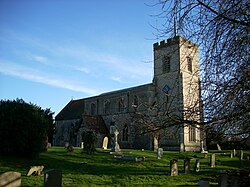Foxton, Cambridgeshire
| Foxton | |
| Cambridgeshire | |
|---|---|
 Parish church of St Lawrence | |
| Location | |
| Grid reference: | TL40944834 |
| Location: | 52°6’54"N, 0°3’31"E |
| Data | |
| Population: | 1,161 (2001) |
| Post town: | Cambridge |
| Postcode: | CB22 |
| Dialling code: | 01223 |
| Local Government | |
| Council: | South Cambridgeshire |
Foxton is a small village in southern Cambridgeshire. It has a number of well-preserved fifteenth- and sixteenth-century houses, and a thirteenth-century church dedicated to St Lawrence.
Known as Foxetune at the time of the Domesday Book, the village's name means just as it seems to; "Fox village".
Running through the village is a stream which was artificially created in the Anglo-Saxon period and maintained as the "common stream" throughout the centuries until culverted in the modern era. It gives a name to Rowland Parker's classic book of local history, The Common Stream (1975), which traces the stream of history in Foxton from the Iron Age to the modern age.
The parish is bounded by the River Granta, across which lies Barringtion. (Parker alleges a longstanding animosity between the two villages, first found in a dispute over the ownership of a mill recorded in the Domesday Book.)
History
The parish has been occupied for at least 2000 years; in the first century A.D. a Belgic settlement appeared, closely followed by a Romano-British farmstead near Hoffer Bridge. A pagan English cemetery has also been found just north of the railway station.[1]
The parish itself was formed over the mediæval period and is bounded on the north by the River Granta and on the northeast and southwest by the Hoffer and Shepreth brooks. Its south-eastern boundary follows an ancient road that runs north-east from Fowlmere, known as the Mareway from the 14th century (now the B1368), and further west by an earthwork known as Grim's ditch or Thriplow bank.[1]
The theologian William Selwyn lived in Foxton House in the village in the 19th century.[1]
Church
There has been a church in Foxton since the 12th century, and it has been dedicated to St Lawrence since at least 1225. The present building, consisting of a west tower, porch, and chancel with aisled and clerestoried nave was probably begun in the 13th century and extended over the following 200 years.[1]
Village life
Foxton has a mainline rail station (opened 1851) to London and is on the main bus route to Cambridge and Royston.
The village has one remaining public house, The White Horse, that has been open since at least 1841, though it was rebuilt after a fire in 1880. Former drinking establishments included The Blackamoor's Head (later renamed The Black Boy) and The Railway Inn, which opened in around 1780 and 1860 respectively, but had both closed by the 1960s.[1]
Foxton is also home to a village shop and post office, primary school, learning centre, educational trust (Villiers Park) and is home to the Burlington Press. The village has a recreation ground with children's playground, tennis courts, bowling green, football pitch and cricket pitches, and there is a modern village hall with meeting rooms and sports pavilion.
The village has a conservation area Foxton Dovecot and Meadow "established" in 2006.[2]
Foxton also has a teenage football club called Dynamo Foxton Football Club.
Literature
The Common Stream by Rowland Parker, published in 1975, is a classic of local history. Its subject is Foxton, and it charts 2000 years of history of the village, from the Celts through the Romans to the Anglo-Saxons and through the Middle Ages to the modern era,[3] with a loving analysis of ancient records.
Outside links
| ("Wikimedia Commons" has material about Foxton, Cambridgeshire) |
References
- ↑ 1.0 1.1 1.2 1.3 1.4 A History of the County of Cambridge and the Isle of Ely, Volume 8 – Victoria County History
- ↑ Friends of the Dovecot Meadow (2006) Foxton Dovecot and Meadow. Foxton, UK: Friends of the Dovecot Meadow, 16pp.
- ↑ The Common Stream